|
Opel Astra
Debut: 2004
Maker: Opel
Predecessor: Astra (1998)
|
|
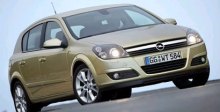 In
the 2003 Geneva motor show, Opel’s new design chief Martin Smith
stunned
the world by showing a concept car called GTC (Grand Touring Compact).
It was known to be a preview of the forthcoming new generation Astra as
well as the styling theme of all other models in the future. Its shape
was sharp and striking. It brought the sexy appeal of sports car to a
hatchback
body. At that moment AutoZine wrote: "If the production car look 50%
this
good, I'm sure Opel's loss will be transformed to a big profit!" In
the 2003 Geneva motor show, Opel’s new design chief Martin Smith
stunned
the world by showing a concept car called GTC (Grand Touring Compact).
It was known to be a preview of the forthcoming new generation Astra as
well as the styling theme of all other models in the future. Its shape
was sharp and striking. It brought the sexy appeal of sports car to a
hatchback
body. At that moment AutoZine wrote: "If the production car look 50%
this
good, I'm sure Opel's loss will be transformed to a big profit!"
Fast forward
to
mid-2004,
the production Opel Astra is of course more conservative, less
sportscar-like
than the GTC for the consideration of practicality, but it is still
easily
the most striking hatchback design since Ford Focus launched in 1998.
It
changes our view on the Astra range, which used to be a boring
bread-and-butter
vehicle. Now what you see is a stylish, aggressive yet elegant design.
It makes Volkswagen Golf dull and Ford Focus outdated. Inside, you will
find the dashboard design no less adventurous. The metal-effect center
console is shaped and organized so cool to look (although in the price
of ergonomics). The plastics are high quality, the build is solid. It
matches
Volkswagen in the quality game and overwhelms it in terms of visual
attractiveness.
We can’t help praising the design team led by Martin Smith for their
job
in Astra, no matter inside or outside.
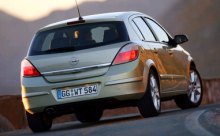 Mechanically,
the new Astra is more conservative than its styling suggests. It
continues
using torsion-beam rear suspensions rather than following Focus and
Golf
to switch to a fully independent suspension. This saves money and space
(it’s slightly more spacious than Golf), but it prevents Astra from
matching
its rivals in handling and ride. To compensate, Opel offers the top
Astra
an optional electronic adaptive damping system called CDC (Continuous
Damping
Control), which is the first of such system in this class. By pushing
the
"Sport" button, damping is stiffened immediately to reduce pitch and
roll
as well as understeer. Simultaneously, the electronic throttle is
sharpened
while the electro-hydraulic power steering weighs up to enhance driver
appeal. Mechanically,
the new Astra is more conservative than its styling suggests. It
continues
using torsion-beam rear suspensions rather than following Focus and
Golf
to switch to a fully independent suspension. This saves money and space
(it’s slightly more spacious than Golf), but it prevents Astra from
matching
its rivals in handling and ride. To compensate, Opel offers the top
Astra
an optional electronic adaptive damping system called CDC (Continuous
Damping
Control), which is the first of such system in this class. By pushing
the
"Sport" button, damping is stiffened immediately to reduce pitch and
roll
as well as understeer. Simultaneously, the electronic throttle is
sharpened
while the electro-hydraulic power steering weighs up to enhance driver
appeal.
In practice,
the
Astra with
CDC is quite fun to drive. It sharpens the handling, making it more
engaging
than Golf. Cars without CDC is less impressive. They lose composure and
run into understeer earlier than Golf and Focus. But no matter with or
without CDC, the Astra’s torsion-beam axle is not a match for its
rivals’
multi-link design in terms of ride quality and suspension noise. In
other
words, it rides harsher and noisier on bumpy surfaces. Another let down
is the electro-hydraulic steering, which lacks real feel despite of
adequate
weighting and accuracy.
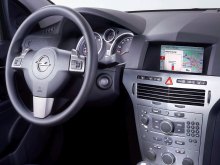 Opel’s
engines used to competitive. This tradition continues in the Astra
range.
In the petrol side, it offers a 90hp Twinport 1.4-litre 16V (Twinport
means
dual-path variable intake manifolds), a 105hp 1.6-litre 16V, a 125hp
1.8-litre
16V and a low-pressure turbocharged 2.0-litre 16V good for 170hp. All
have
iron block, implying they are upgraded versions of the Lotus-developed
Ecotec series which served Opel many years. Don’t confuse them with
Fiat
or Saab’s all-alloy engines. In the diesel side, however, it employs
Fiat’s
famous 1.9 Multijet common-rail turbo diesel engine with 150hp output,
though it is rebadged to 1.9CDTI. Opel’s
engines used to competitive. This tradition continues in the Astra
range.
In the petrol side, it offers a 90hp Twinport 1.4-litre 16V (Twinport
means
dual-path variable intake manifolds), a 105hp 1.6-litre 16V, a 125hp
1.8-litre
16V and a low-pressure turbocharged 2.0-litre 16V good for 170hp. All
have
iron block, implying they are upgraded versions of the Lotus-developed
Ecotec series which served Opel many years. Don’t confuse them with
Fiat
or Saab’s all-alloy engines. In the diesel side, however, it employs
Fiat’s
famous 1.9 Multijet common-rail turbo diesel engine with 150hp output,
though it is rebadged to 1.9CDTI.
Strangely,
there
is no 2.0-litre
normally aspirated engine. Its task is fulfilled by the low-pressure
turbocharged
2.0. As a 200hp high-pressure turbo will arrive later, the 170hp engine
is not intended to be a hot performer. Instead, its strength is a flat
torque curve (184 lbft from 1950-4000rpm) and uncanny refinement. The
6-speed
manual gearbox mated with this engine is also a delight, as it shifts
quickly
and precisely and its tall gearing takes advantage of the torquey
engine
to enhance motorway cruising refinement. Not so good the 5-speed manual
for lesser engines, blame to its notchy gearchange.
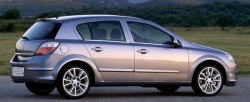 At
the time of writing, the 1.9 CDTI turbo diesel is not yet available,
but
from our experience in Alfa Romeo 156 1.9JTD which employ the same
engine,
it is easily the best engine in the range. It produces even more torque
than the most powerful petrol engine (that’s 225 lbft), drinks far less
fuel and being equally refined. Thanks God, it also couples to the
6-speed
manual. This combination is an appealing package, not even Golf can
provide
such a satisfying diesel powertrain. Driven by the
successful
design, Astra is stealing sales from Golf. It is not just a coincidence
that Golf V is selling disappointingly across Europe and has to offer
free
air-con etc. from the very beginning while Opel has to increase the
production
of Astra to meet stronger than expected demand. However, the Volkswagen
still has a noticeable advantage in suspension design, which reflects
in
ride and handling. On the other hand, Ford Focus is still the best
driver’s
car in the class. Astra is not yet there. At
the time of writing, the 1.9 CDTI turbo diesel is not yet available,
but
from our experience in Alfa Romeo 156 1.9JTD which employ the same
engine,
it is easily the best engine in the range. It produces even more torque
than the most powerful petrol engine (that’s 225 lbft), drinks far less
fuel and being equally refined. Thanks God, it also couples to the
6-speed
manual. This combination is an appealing package, not even Golf can
provide
such a satisfying diesel powertrain. Driven by the
successful
design, Astra is stealing sales from Golf. It is not just a coincidence
that Golf V is selling disappointingly across Europe and has to offer
free
air-con etc. from the very beginning while Opel has to increase the
production
of Astra to meet stronger than expected demand. However, the Volkswagen
still has a noticeable advantage in suspension design, which reflects
in
ride and handling. On the other hand, Ford Focus is still the best
driver’s
car in the class. Astra is not yet there. |
| The
above report was last updated on 3 Aug 2004. All
Rights Reserved. |
Astra GTC
|
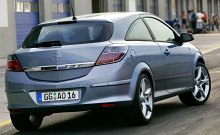 The
previous generation Astra Coupe was a compromise between practicality
and style. Sometimes you wonder how it could look duller than some hot
hatches and therefore why not simply build a hot hatch instead of a
coupe. This view is shared with ex-Opel design boss Martin Smith. In
2003, he created a concept car called GTC (Gran Turismo Compact). The
car looked very sleek and aggressive, but it was actually a 3-door
hatchback version of the to-be-launched new Astra. Compare to the Astra
5-door, the GTC had a more steeply raked windscreen, lower roof,
stronger shoulders and sharper rear end styling. This hatchback looked
even sexier than many coupes. The
previous generation Astra Coupe was a compromise between practicality
and style. Sometimes you wonder how it could look duller than some hot
hatches and therefore why not simply build a hot hatch instead of a
coupe. This view is shared with ex-Opel design boss Martin Smith. In
2003, he created a concept car called GTC (Gran Turismo Compact). The
car looked very sleek and aggressive, but it was actually a 3-door
hatchback version of the to-be-launched new Astra. Compare to the Astra
5-door, the GTC had a more steeply raked windscreen, lower roof,
stronger shoulders and sharper rear end styling. This hatchback looked
even sexier than many coupes.
The GTC finally went into production. Its aggressive shape is slightly
tamed, but it is still a handsome car. Being a hatchback, the GTC has
so much more headroom and legroom for the rear passengers. Those under
6 feet will find the place comfortable. Now handsome exterior styling
and spacious interior are no longer mutually exclusive.
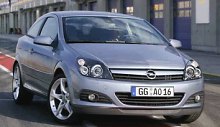 GTC is
provided with all the engines of the 5-door Astra, from 90hp 1.4 to
170hp 2.0 turbo. On the top of these, there is a 200 hp version of the
2.0 turbo engine. Similar to the one used in the previous Astra Coupe
turbo, this engine delivers strong mid-range punch and little turbo
lag. Opel claims it take 7.4 seconds for 0-60 mph acceleration, which
seems to be in the conservative side. For your information, the
previous Astra Coupe turbo took 7.2 seconds to do that even though it
did not have a 6-speed gearbox like the new GTC. GTC is
provided with all the engines of the 5-door Astra, from 90hp 1.4 to
170hp 2.0 turbo. On the top of these, there is a 200 hp version of the
2.0 turbo engine. Similar to the one used in the previous Astra Coupe
turbo, this engine delivers strong mid-range punch and little turbo
lag. Opel claims it take 7.4 seconds for 0-60 mph acceleration, which
seems to be in the conservative side. For your information, the
previous Astra Coupe turbo took 7.2 seconds to do that even though it
did not have a 6-speed gearbox like the new GTC.
Nevertheless, the 2.0 turbocharged engine is not the sweetest engine
around – that should be Volkswagen group's 200hp 2.0 TFSI engine. The
latter has a wider power band, a freer top end and lack of the Opel's
slightly annoying turbocharger noise.
 In terms
of driving, the GTC differs little from the 5-door Astra. To reserve
the sportiest driving character for the forthcoming OPC version, Opel
deliberately tuned the 200hp GTC to be more civilized. That means it
does not intend to be a direct competitor to the hottest hatchbacks
such as Golf GTI, Alfa 147 GTA and Honda Civic Type R. The GTC is more
about comfort and accessible performance. Its 225/45ZR17 tires and CDC
electronic damping shine in high speed cornering. The IDS control
system, which provides a Sport mode button to sharpen throttle
response, weight up the power steering and stiffen suspension damping,
is quite playful. However, there is no replacement to a set of stiff
springs and an inherently communicative steering. Moreover, the
iron-block engine put 66% weight over the front axle, causing too much
understeer to the delight of keen drivers. In terms
of driving, the GTC differs little from the 5-door Astra. To reserve
the sportiest driving character for the forthcoming OPC version, Opel
deliberately tuned the 200hp GTC to be more civilized. That means it
does not intend to be a direct competitor to the hottest hatchbacks
such as Golf GTI, Alfa 147 GTA and Honda Civic Type R. The GTC is more
about comfort and accessible performance. Its 225/45ZR17 tires and CDC
electronic damping shine in high speed cornering. The IDS control
system, which provides a Sport mode button to sharpen throttle
response, weight up the power steering and stiffen suspension damping,
is quite playful. However, there is no replacement to a set of stiff
springs and an inherently communicative steering. Moreover, the
iron-block engine put 66% weight over the front axle, causing too much
understeer to the delight of keen drivers.
That said, the GTC is an attractive package for most people. It looks
as handsome as a coupe, works as practical as any hatchbacks and
delivers a good compromise between comfort and driver appeal at an
affordable price. Opel expects to sell 70,000 units of this car
annually, which accounts for 15-20% of the total Astra sales.
GTC with Panoramic roof
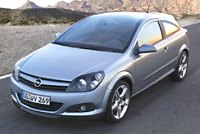 
Astra GTC is the world's first production car employing a panoramic
glass roof without the usual cross beam at the windscreen edge. The
glass windscreen extends seamlessly from the bonnet to the roof as far
as the B-pillars, creating a completely free environment to the front
occupants. Look at the inside picture: the rear view mirror looks like
hanging from the sky !
The panoramic roof adds just 10kg to the GTC. It is made of 6mm thick
laminated safety glass with solar protection. Besides, a stepless
adjustable shading system is provided to deal with strong sunshine. To
compensate the loss of the crossmember at the windscreen top edge, A
and B-pillars are strengthened, while an extra cross-member is added in
the middle of the roof. Opel claims crash protection is not affected.
|
| The
above report was last updated on 4 Jun 2005. All
Rights Reserved. |
Astra OPC
|
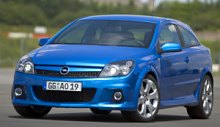 OPC
stands for Opel Performance Center, which is the performance car
division of Opel. The first OPC-badged car was the 1999 Astra OPC. It
was based on the last generation Astra and powered by a highly tuned,
160 horsepower 2-litre 16V engine. It was not very fast, but it has
sharp handling to please keen drivers. At the time, AutoZine ranked it
just behind the wonderful Peugeot 306 GTi-6. OPC
stands for Opel Performance Center, which is the performance car
division of Opel. The first OPC-badged car was the 1999 Astra OPC. It
was based on the last generation Astra and powered by a highly tuned,
160 horsepower 2-litre 16V engine. It was not very fast, but it has
sharp handling to please keen drivers. At the time, AutoZine ranked it
just behind the wonderful Peugeot 306 GTi-6.
Such driver appeal never returned since then. A couple of years ago,
Opel developed a 200hp turbocharged Astra OPC. Unfortunately, apart
from stronger performance, the car didn't quite match the original
OPC's sharpness and entertainment, because its chassis was set too
civilized. Inevitably, Astra OPC ranked behind class rivals Honda Civic
Type R and new Golf GTi.
The Golf GTi is especially a good package. It has a marvelous engine, a
good compromise between handling and ride and Volkswagen-standard build
quality. However, at 200 horsepower, it is definitely slow, especially
if you consider the premium price it asks. If OPC can offer more
performance for less money, it could break the domination of Golf GTi.
Now this car has finally come – the new Astra OPC. In the five areas we
evaluate cars, namely 1) Design 2) Engine and performance, 3) Handling,
4) Ride and 5) Comfort and quality, it beats the Golf in the first 3 of
them. At £19,000 in the UK (where it is called Vauxhall Astra
VXR), it is also £1,000 cheaper than the Golf.
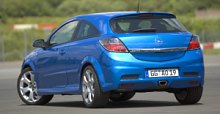 We
start from styling. The OPC has a killer look really. It is based on
the coupe-like GTC hatchback, which is already a beautiful design, and
then added with aggressive air dam, cooling intakes, skirts, spoilers,
eye-catching 18-inch wheels etc. The result is a look that sets boy
racers on fire at the first sight. I am glad to see Opel did not follow
the trend of other so-called “hot hatches” to go civilized in styling.
Hot hatches should look hot, shouldn't they? We
start from styling. The OPC has a killer look really. It is based on
the coupe-like GTC hatchback, which is already a beautiful design, and
then added with aggressive air dam, cooling intakes, skirts, spoilers,
eye-catching 18-inch wheels etc. The result is a look that sets boy
racers on fire at the first sight. I am glad to see Opel did not follow
the trend of other so-called “hot hatches” to go civilized in styling.
Hot hatches should look hot, shouldn't they?
Powerful engine is also a must. The Astra OPC has its 2.0 turbocharged
engine based on the GTC's 200 hp version, but it is boosted to 240
horsepower and 236 lbft of torque by using a bigger turbocharger
running at 1.2 bar, high-flow intercooler, forged aluminum pistons, oil
spray cooling to pistons... note that the twin-balancer shafts have
been discarded for lighter rotational mass thus quicker response. This
means it is not as smooth as the 200 hp version nor the Golf's 2.0 TFSI
engine, but I would say smoothness is less critical to hot hatches.
Apart from some ultra-expensive premium hatches (Alfa Romeo 147 GTA,
BMW 130i, Audi A3 V6, VW Golf R32 and if you count, the mid-engined
Renault Sport Clio V6), Astra's 240 horsepower engine is the most
powerful among hot hatches. It beats Golf GTi by a decisive 40 hp and
Renault Sport Megane Turbo by 15 hp. In real world, it is also the
fastest, no matter against the clock or in subjective terms. Compare
with Renault Megane, Opel's power band is stronger from mid-range to
the top end, while the Renault is stronger at the lower spectrum.
However, this is not to say the OPC lack of tractability. In fact, it
has too little turbo lag to mention, thanks to a turbocharger
integrating with the exhaust manifold as a single unit, shortening the
path between combustion chambers and turbine.
 To keen
drivers, the relative lack of low end grunt is exactly what tempt them
to squeeze more rev. Once entering the 2400-5000 rpm band, all 236 lbft
of torque is available, pushing the Astra OPC at lightning speed. 0-60
mph can be finished in 6.1 seconds, virtually matching the
aforementioned premium hot hatches. To keen
drivers, the relative lack of low end grunt is exactly what tempt them
to squeeze more rev. Once entering the 2400-5000 rpm band, all 236 lbft
of torque is available, pushing the Astra OPC at lightning speed. 0-60
mph can be finished in 6.1 seconds, virtually matching the
aforementioned premium hot hatches.
Handling is another strength of the OPC. Its chassis is tuned by OPC in
Nurburgring in conjunction with Lotus Engineering. Compare with the
regular GTC,
its suspensions are stiffened and lowered by 15 mm. Dampers with
rebound springs are employed to improve ride composure. Besides, the
steering knuckle geometry is revised. No wonder it has no such
understeer experienced in GTC. Compare with Golf GTi and Megane Turbo,
it steers into corner much more neutral. In twisty roads, the OPC feels
sharper, sportier and faster than its rivals. Its 225/40 tires provide
bags of grip, while adaptive damping and IDS-plus control (which alter
throttle response and steering weight) enhance handling even further at
the press of Sport button. Another surprise is ride quality, which
isn't hampered by the sporty suspensions and tires, thanks to fine
damping.
Inevitably, such a driver-focused machine has some rough edges, namely,
a little bit torque steer under hard acceleration, uninspiring noise
from the turbo engine and short of brake feel. However, considering the
driving excitement it offers, these are just minor issues. From now on,
Astra OPC replaces Golf GTi as our favourite hot hatch. |
| The
above report was last updated on 15 Aug
2005. All Rights Reserved. |
Astra TwinTop
|
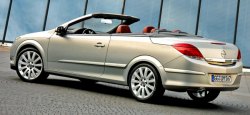 In
1997, Mercedes SLK pioneered the first modern retractable roof
mechanism. By the press of a button, the metal roof folded
automatically into the boot, converting the car from coupe to
cabriolet. In coupe form, it provided the noise and weather insulation
unachievable by conventional cabriolets, as well as superior chassis
rigidity. This technology became a hit immediately and orders flooded
to Mercedes-Benz dealers. In
1997, Mercedes SLK pioneered the first modern retractable roof
mechanism. By the press of a button, the metal roof folded
automatically into the boot, converting the car from coupe to
cabriolet. In coupe form, it provided the noise and weather insulation
unachievable by conventional cabriolets, as well as superior chassis
rigidity. This technology became a hit immediately and orders flooded
to Mercedes-Benz dealers.
SLK remained unique until 2001, when Peugeot launched 206CC. The little
Peugeot successfully drove tractable roof technology to a low price
segment. It became an even bigger hit, attracting an incredible 100,000
units sales a year ! its success triggered many car makers to follow
suit. At the same time, several retractable roof makers started
emerging – Heuliez, CTS, Oasys (Pininfarina-Webasto) and Karmann. They
help car makers to
develop and produce virtually all of the world’s retractable roof
systems.
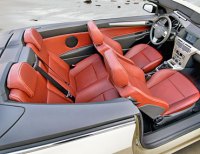 The roof of Opel Astra TwinTop
comes from CTS, a German company formerly co-owned by Porsche and
Mercedes. It also made the roof for Peugeot 307CC. However, the latest
roof in Astra TwinTop is undoubtedly more advanced than the Peugeot’s.
Like the recent Volvo C70, its roof splits into 3 smaller pieces
instead of 2 larger pieces when fold into the boot. This enables a
shorter boot which is more coherent to the coupe shape. Besides, as the
3-piece roof is longer than 2-piece roof, the windscreen does not need
to rake steeply, hence freeing headroom for the front occupants. As a
result, Astra’s roof has none of the packaging compromises found in
Peugeot 307CC, Renault Megane CC and Ford Focus CC. The roof of Opel Astra TwinTop
comes from CTS, a German company formerly co-owned by Porsche and
Mercedes. It also made the roof for Peugeot 307CC. However, the latest
roof in Astra TwinTop is undoubtedly more advanced than the Peugeot’s.
Like the recent Volvo C70, its roof splits into 3 smaller pieces
instead of 2 larger pieces when fold into the boot. This enables a
shorter boot which is more coherent to the coupe shape. Besides, as the
3-piece roof is longer than 2-piece roof, the windscreen does not need
to rake steeply, hence freeing headroom for the front occupants. As a
result, Astra’s roof has none of the packaging compromises found in
Peugeot 307CC, Renault Megane CC and Ford Focus CC.
Observing from outside, Astra TwinTop looks handsome. It is sleeker and
more civilized than Astra GTC. Inside, it shares the same stylish
dashboard with the hatchback. The driving position is comfortable. At
the back, the seats are more suitable for children as they are short of
head and legroom. This is because the roof mechanism and the pop-up
rollover bars eat into cabin room. In fact, all rivals bar Volvo C70
have the same problem.
 Like most other cars of the
same kind, Astra TwinTop carries considerably more weight than the
fixed roof version. The electro-hydraulic mechanism of the roof, the
compensating reinforcement to the chassis, the pop-up rollover bars and
the longer boot contribute to around 200 kilograms. As a result, the
smallest 1.6-litre engine (105hp) and 1.8-litre engine (140hp) are too
weak to be recommended. You need to order at least the 170hp 2.0 turbo
engine, or preferably the torquey 1.9 turbo diesel and the
range-topping 200hp 2.0 turbo petrol. However, none of them are
supposed to be fireball. Those buying this kind of cars must prepare to
accept inferior performance. For instance, the 200hp 2.0 turbo takes
8.4 seconds to do 0-60 mph, some 1.0 seconds longer than the equivalent
GTC. Like most other cars of the
same kind, Astra TwinTop carries considerably more weight than the
fixed roof version. The electro-hydraulic mechanism of the roof, the
compensating reinforcement to the chassis, the pop-up rollover bars and
the longer boot contribute to around 200 kilograms. As a result, the
smallest 1.6-litre engine (105hp) and 1.8-litre engine (140hp) are too
weak to be recommended. You need to order at least the 170hp 2.0 turbo
engine, or preferably the torquey 1.9 turbo diesel and the
range-topping 200hp 2.0 turbo petrol. However, none of them are
supposed to be fireball. Those buying this kind of cars must prepare to
accept inferior performance. For instance, the 200hp 2.0 turbo takes
8.4 seconds to do 0-60 mph, some 1.0 seconds longer than the equivalent
GTC.
Another compromise is chassis stiffness. This may not be a big problem
to Mercedes SLK, but to 4-seaters like Peugeot 307CC and Renault Megane
CC, the large opening ruins chassis rigidity significantly. Astra
TwinTop feels stiffer than its French rivals. As long as the roof is
closed, it displays very little chassis shake and flex. The suspension
setup is stiffer than its rivals, but it transmits little harshness
into the cabin, thanks to the superior chassis stiffness. Nevertheless,
when the roof is down, chassis stiffness is noticeably worsen. This is
especially apparent when the car is riding on broken surfaces. Again,
this car is not supposed to match the fixed roof version for handling
and ride.
Like most of its kind, Astra TwinTop feels most comfortable to be
driven leisurely on motorway. It is certainly more capable and
desirable than 307CC and Megane CC, but there is still a long way to go.
|
| The
above report was last updated on 19 Apr
2006. All Rights Reserved. |
|
|